The Marshmallow Tower Challenge is a fun, collaborative activity where teams use limited materials to build the tallest freestanding structure supporting a marshmallow within 18 minutes.
Overview of the Marshmallow Tower Challenge
The Marshmallow Tower Challenge is a popular team-building activity that encourages creativity, problem-solving, and collaboration. Teams are tasked with building the tallest freestanding structure using limited materials—typically spaghetti sticks, tape, string, and a marshmallow—within a set time frame, usually 18 minutes. The goal is to create a stable structure that can support the marshmallow without collapsing. This exercise emphasizes engineering principles, iteration, and teamwork, making it a fun and educational experience for participants of all ages. It also highlights the importance of communication and adaptability under pressure.
Importance of Teamwork and Problem-Solving
The Marshmallow Tower Challenge underscores the vital role of teamwork and problem-solving in achieving success. Participants must collaborate effectively, assigning roles and sharing ideas to design a stable structure. Communication is key to ensuring all team members contribute and understand the plan. Problem-solving skills are put to the test as teams face challenges like material limitations and structural instability. This activity fosters creativity, adaptability, and resilience, teaching participants that failure is an opportunity to learn and improve. By working together, teams can overcome obstacles and build a successful tower, highlighting the power of collaboration and innovative thinking.

Objective of the Marshmallow Tower Challenge
The primary goal is to build the tallest freestanding structure using limited materials that can support a marshmallow without collapsing within a set time frame.
Building the Tallest Freestanding Structure
Teams aim to construct the tallest possible tower using 20 spaghetti sticks, tape, and string. The structure must be freestanding and stable, balancing height with durability. Engineering principles like distribution of weight and balance are crucial. Teams often test multiple iterations, refining their designs to maximize height while ensuring stability. The challenge lies in creating a sturdy base, gradually adding height, and ensuring the structure can withstand gravity without collapsing. Creativity and precision are key to achieving the tallest tower that meets the requirements.
Supporting the Marshmallow
The ultimate goal is to ensure the marshmallow remains securely atop the structure without causing it to collapse. The tower must hold the marshmallow for at least three seconds without external support. Teams must balance flexibility and rigidity in their design to absorb the marshmallow’s weight while maintaining stability. Testing the structure before placing the marshmallow is crucial to identify weaknesses. The marshmallow should be centered and securely attached using minimal tape or string to avoid adding unnecessary weight. A stable base and even distribution of weight are essential to prevent the structure from leaning or toppling under the marshmallow’s load.

Materials Needed for the Challenge
The challenge requires specific materials, including 20 sticks of spaghetti, one yard of tape, one yard of string, and one marshmallow.
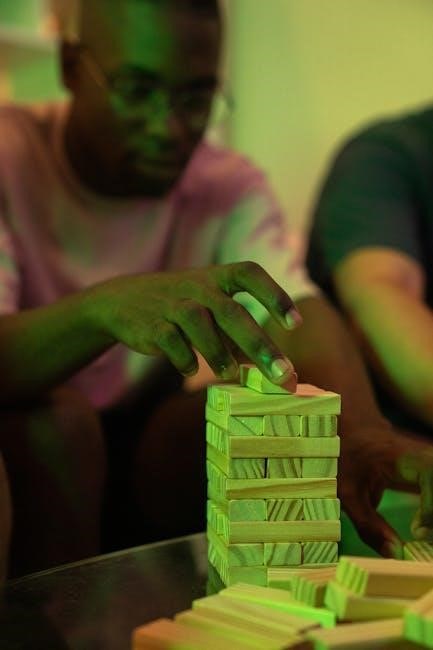
Spaghetti Sticks
The primary building material for the challenge is 20 sticks of dry spaghetti. These sticks serve as the structural foundation of the tower. Participants must use the spaghetti to create a sturdy yet lightweight framework capable of supporting the marshmallow. The spaghetti sticks can be broken into smaller pieces to distribute weight evenly and create a stable base. Teams often use the sticks to form a lattice or grid pattern, which enhances strength while minimizing material usage. Properly arranging the spaghetti is crucial for achieving both height and stability in the tower.
Tips for using spaghetti sticks effectively include breaking them strategically to optimize their length and strength. Longer sticks can be used for the base, while shorter pieces are better suited for upper sections. Securing the sticks firmly with tape or string ensures a solid structure. Teams must balance flexibility and rigidity to prevent the tower from collapsing under the marshmallow’s weight. Experimentation with different configurations is key to maximizing the tower’s height and durability.
Tape and String
Tape and string are essential for binding the spaghetti sticks together, providing structural integrity to the tower. Teams are typically allocated one yard of tape and one yard of string. These materials help secure the spaghetti framework, ensuring stability and flexibility. Properly wrapping tape around joints strengthens weak points, while string can be used to reinforce critical sections or tie parts together. Effective use of tape and string maximizes the tower’s durability without adding excessive weight. Teams must strategically allocate these resources to achieve the perfect balance between strength and flexibility, ensuring the structure can support the marshmallow without collapsing.
Using tape and string wisely is crucial, as they are limited resources. Teams often wrap tape around key joints to reinforce stability, while string is used to tie multiple sections together. This combination enhances the tower’s overall strength and helps distribute the weight evenly. Proper application ensures the structure remains sturdy and can withstand the marshmallow’s weight. Experimenting with different wrapping techniques can significantly improve the tower’s stability and height, making tape and string indispensable in the challenge.
Marshmallow
The marshmallow is the final component of the challenge, placed atop the tower to test its structural integrity. Teams must ensure their structure can support the marshmallow without collapsing. The marshmallow’s size and weight are uniform, making it a consistent test of the tower’s stability. Proper placement is crucial, as the marshmallow must remain balanced and secure. Teams often wait until the last moment to place it, minimizing the risk of damage during construction. The marshmallow serves as both a challenge and a symbol of the team’s engineering prowess.
The marshmallow’s soft texture requires careful handling to avoid compression or damage. Teams must design their tower with enough strength to bear the marshmallow’s weight without compromising its balance; The challenge lies in creating a sturdy yet delicate structure capable of supporting the marshmallow securely. This final step is a true test of the team’s problem-solving skills and attention to detail, as even the slightest instability can lead to failure.
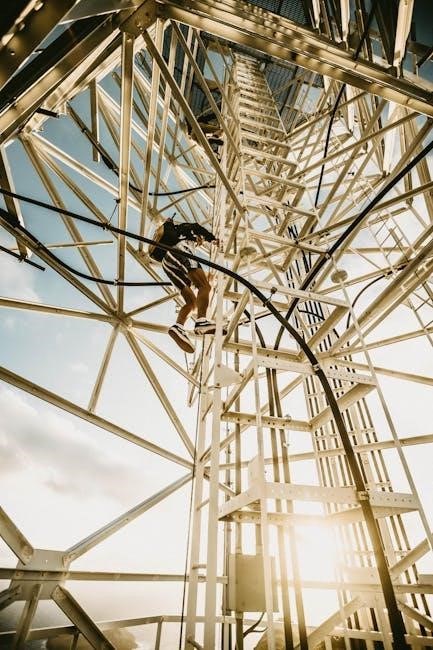
Setting Up the Challenge
Setting Up the Challenge involves gathering materials like spaghetti, tape, and marshmallows. Arrange the activity area, ensuring space for each team to work. Brief participants on rules.
Preparation of Materials
Begin by gathering and organizing all necessary materials. Count and distribute 20 spaghetti sticks per team. Measure and cut one yard each of tape and string; Ensure each team has one marshmallow. Prepare additional materials for backup. Organize supplies in accessible locations for easy distribution. Make sure all items are within reach to save time. Brief participants on material usage to avoid waste. Emphasize the importance of handling materials carefully to maintain structural integrity. Proper preparation ensures a smooth start and allows teams to focus on building their towers efficiently within the given time frame.
Activity Area Setup
Arrange the activity area to accommodate all teams comfortably. Ensure each team has a sturdy table or workspace. Place materials within easy reach to minimize movement. Designate specific zones for building and testing. Clear the floor of obstacles to prevent tripping. Set up a central area for material distribution. Ensure good lighting for visibility. Assign a judging zone for measuring towers. Keep extra supplies nearby for quick access. Maintain a safe distance between teams to avoid accidental interference. Ensure the space is well-ventilated and free from distractions. Organize waste bins for discarded materials. This setup promotes efficiency and focus during the challenge.
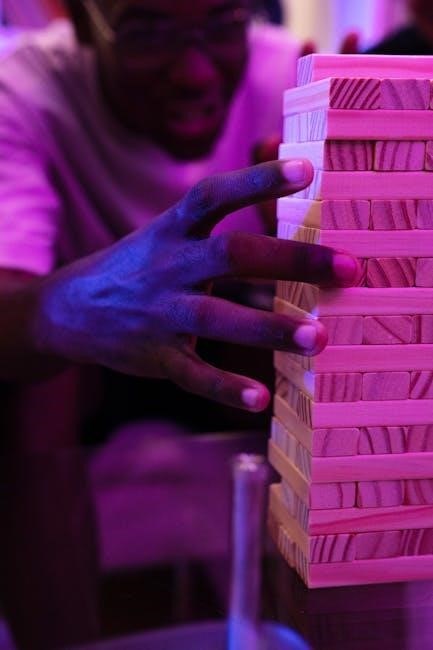
Step-by-Step Instructions
Teams must build the tallest freestanding structure using spaghetti, tape, and string within 18 minutes, culminating in placing a marshmallow on top without the tower collapsing.
Planning the Structure
Planning is a critical phase in the Marshmallow Tower Challenge. Teams should brainstorm ideas, discuss material usage, and consider geometric shapes for stability. Sketching a design helps visualize the tower’s base, height, and support points. Assigning roles ensures efficient collaboration. Teams must balance structure height with stability, as taller towers are more unstable. Considering the marshmallow’s weight, the design should distribute pressure evenly. A well-planned strategy increases the chances of building a durable and towering structure within the time limit.
Building the Base
Constructing a sturdy base is essential for a stable tower. Begin by arranging spaghetti sticks into a wide, balanced shape, such as a triangle or square. Secure the sticks together using tape or string, ensuring tight bonds for strength. A wider base provides better stability, reducing the risk of collapse. Use multiple layers of sticks to reinforce the foundation. Ensure the base is flat and even to support the weight of the marshmallow and additional structure. A well-built base sets the stage for a taller, more durable tower;
Adding Height and Stability
After constructing the base, focus on adding height while maintaining stability. Begin by stacking spaghetti sticks vertically, securing them with tape or string to the base. Use a crisscross pattern to reinforce each layer, ensuring even weight distribution. As you add height, test the tower’s stability by gently shaking it. If it wobbles, reinforce weak points with additional tape or sticks. Gradually build upward, keeping the structure balanced to prevent collapse. Each layer should be slightly narrower than the one below to maintain strength and support the marshmallow effectively.
Placing the Marshmallow
Once your tower is stable and tall enough, carefully place the marshmallow on top. Gently set it in the center to avoid applying too much pressure, which could cause the structure to collapse. Ensure the marshmallow is securely positioned and the tower remains upright. After placement, observe the tower for a few seconds to check for any signs of instability or sagging. If it holds firm, your team has succeeded! The challenge is complete when the marshmallow remains supported without the structure toppling. This step requires precision and patience to ensure the tower’s balance is maintained.

Tips and Tricks for Success
Use tape strategically, distribute weight evenly, and test the structure gradually. Focus on balance and stability over height initially to ensure a strong foundation for the marshmallow.
Common Mistakes to Avoid
Teams often rush to build tall structures without ensuring stability, leading to collapses. Overusing tape can make the tower heavy and unstable. Neglecting to test the structure incrementally can result in sudden failures. Poor communication and lack of a clear plan often lead to inefficient designs. Additionally, focusing too much on height early on can compromise the foundation’s strength. Avoiding these mistakes requires careful planning, gradual testing, and effective teamwork to ensure the marshmallow tower stands tall and stable.
Effective Strategies
Effective strategies for the Marshmallow Tower Challenge involve careful planning and execution. Start by building a sturdy base to ensure stability. Use triangulation to reinforce the structure, as triangles are inherently strong shapes. Distribute the weight evenly to prevent the tower from leaning or collapsing. Incremental testing is key—build and test small sections before adding height. Prioritize communication and collaboration within the team to maximize efficiency. Finally, allocate materials wisely, avoiding excessive use of tape or spaghetti in any single section. These strategies enhance stability and increase the chances of building a tall, marshmallow-supporting tower.
Leadership and Communication
Leadership and communication are critical to success in the Marshmallow Tower Challenge. Assign roles to team members to ensure tasks are divided evenly, fostering collaboration. Encourage open communication to share ideas and address challenges promptly. A leader should guide the team, while also empowering members to contribute creatively. Clear and concise instructions help avoid misunderstandings, while active listening ensures everyone’s input is valued. Regular check-ins and feedback loops allow the team to adapt and improve iteratively. Strong leadership and effective communication build trust and confidence, essential for overcoming obstacles and achieving the challenge’s goals efficiently.

Variations of the Challenge
The challenge can be adapted for different age groups, team sizes, or by adding constraints like limited materials or unusual building items to increase complexity.
Different Age Groups
The Marshmallow Tower Challenge can be tailored to suit various age groups, ensuring engagement and skill development across different stages. For younger participants, simpler materials and shorter timeframes encourage creativity and basic engineering concepts. Older groups can face more complex constraints, promoting advanced problem-solving and strategic thinking. This adaptability makes the challenge versatile for educational settings, corporate team-building, and family activities. By adjusting difficulty levels, the exercise remains effective in fostering innovation and collaboration across diverse demographics, making it a universally appealing activity.
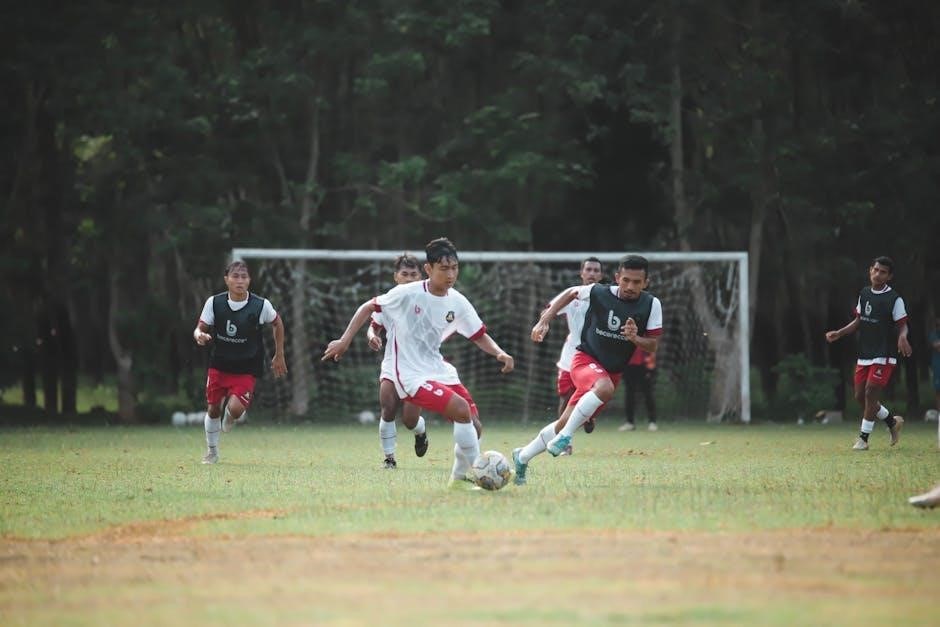
Team Size Variations
The Marshmallow Tower Challenge can accommodate various team sizes, enhancing collaboration and problem-solving. Classic teams consist of four members, fostering balanced roles and responsibilities. Smaller teams of two or three encourage individual contribution and rapid decision-making. Larger groups of five or six promote diverse perspectives but require stronger communication. Adjusting team sizes allows the challenge to cater to different group dynamics, ensuring active participation. Whether with fewer or more members, the core objective remains the same: building a stable, marshmallow-topped structure. This flexibility makes the activity suitable for classrooms, workshops, or corporate events, emphasizing adaptability and teamwork.
Additional Constraints
To enhance the challenge, additional constraints can be introduced to test creativity and efficiency. Teams might be limited to specific materials, such as only 20 spaghetti sticks or a restricted amount of tape. Time constraints, like a shorter building period, add pressure. Some variations require the structure to fit within a defined base size or include a penalty for unstable towers. Environmental challenges, like building on uneven surfaces, can also be added. These constraints ensure teams must innovate and adapt, pushing their problem-solving skills to the limit while maintaining the core objective of supporting the marshmallow.
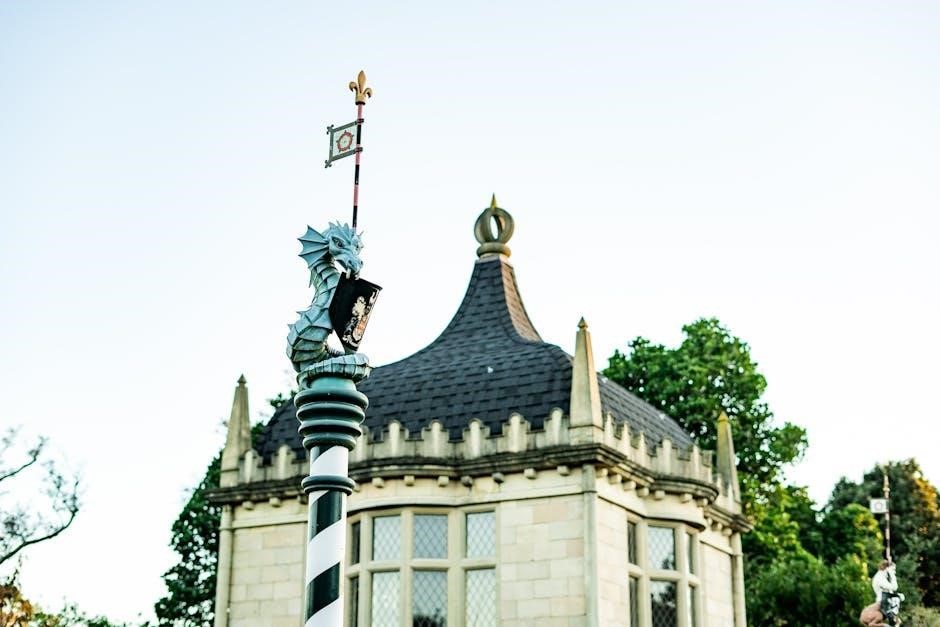
Science Behind the Challenge
The Marshmallow Tower Challenge demonstrates principles of structural integrity and tension. The marshmallow represents a load, testing the tower’s ability to distribute weight without collapsing.
Structural Integrity
Structural integrity is crucial in the Marshmallow Tower Challenge, as it determines whether the tower can support the marshmallow without collapsing. The design must effectively distribute the weight of the marshmallow across the structure, relying on principles of tension and compression. Sturdy bases and balanced frameworks help maintain stability, while shapes like triangles and squares provide natural strength. Teams often fail when their structures cannot withstand the marshmallow’s weight, highlighting the importance of testing and iterating designs. A well-engineered tower demonstrates how shape, material arrangement, and balance contribute to overall stability and success in the challenge.
Role of the Marshmallow
The marshmallow serves as the final test of the tower’s stability and design. Its weight, though minimal, poses a significant challenge, as it must be supported without causing collapse. Teams often underestimate the impact of the marshmallow, leading to structural failures. The marshmallow’s placement requires precision, ensuring it sits securely at the tower’s peak. Its role emphasizes the importance of a strong, balanced structure and the need for careful planning and execution. The marshmallow ultimately reveals the effectiveness of the team’s engineering and collaboration efforts, making it a critical component of the challenge.
Learning Outcomes
The Marshmallow Tower Challenge fosters problem-solving, iteration, and teamwork. Participants learn to collaborate, communicate effectively, and adapt designs through trial and error, enhancing critical thinking skills.
Problem-Solving Skills
The Marshmallow Tower Challenge enhances problem-solving abilities by encouraging teams to think creatively and adapt designs under time constraints. Participants learn to analyze structural weaknesses, experiment with materials, and refine their approach through trial and error. This activity simulates real-world challenges, teaching individuals to remain flexible and resourceful when faced with unexpected obstacles. By collaborating to find solutions, teams develop critical thinking skills and improve their ability to approach complex tasks systematically. These problem-solving strategies are valuable beyond the challenge, fostering innovation and resilience in various aspects of life.
Iteration and Experimentation
Iteration and experimentation are core components of the Marshmallow Tower Challenge, fostering a mindset of continuous improvement. Teams begin with initial designs, test their structures, and refine them based on what works and what doesn’t. This process encourages participants to embrace failure as a learning opportunity, understanding that each iteration brings them closer to a successful solution. By repeatedly adjusting their approach, teams develop a deeper understanding of structural integrity and material limitations. This hands-on learning mirrors real-world engineering and design thinking, preparing participants to tackle complex challenges with resilience and creativity.
Team Collaboration
Team collaboration is essential for success in the Marshmallow Tower Challenge, as it requires diverse skills and perspectives to design and build a stable structure. Each team member brings unique ideas, fostering creativity and innovation. Open communication ensures that everyone’s input is valued, leading to more effective problem-solving. Collaborative efforts help distribute tasks efficiently, allowing teams to work cohesively toward a common goal. Strong teamwork not only enhances the building process but also strengthens interpersonal bonds, making the challenge a valuable exercise in unity and shared responsibility.
Safety Precautions
Ensure a safe environment by properly clearing the activity area of tripping hazards and handling materials carefully. Supervise young participants to prevent any accidents.
Ensuring a Safe Environment
Before starting the Marshmallow Tower Challenge, ensure the activity area is clear of tripping hazards and breakable objects. Secure any loose items that could fall or cause injury. Participants should handle materials like spaghetti and tape carefully to avoid accidents. Supervise young children closely, especially when using sharp objects or materials that may pose a choking hazard. Encourage teams to work in a stable, flat surface and avoid overreaching or climbing. Have a first aid kit nearby and ensure everyone understands the importance of safety throughout the activity. This preparation helps create a secure environment for all participants.
Handling Materials Safely
Ensure all materials are handled with care to prevent accidents. Spaghetti sticks should not be snapped or thrown, as they can cause eye injuries. Tape and string should be cut safely, preferably with blunt scissors, to avoid sharp edges. Marshmallows, while soft, should be kept away from faces and mouths to prevent choking. Participants should avoid overstretching or pulling materials forcefully, which could lead to tripping or collisions. Supervise children closely, especially when handling small or sharp objects. Encourage responsible handling of materials to maintain a safe and enjoyable environment for everyone involved in the challenge.
The Marshmallow Tower Challenge fosters creativity, teamwork, and problem-solving skills, offering a fun and engaging way to learn through hands-on experience and collaboration.
The Marshmallow Tower Challenge is a dynamic team-building activity that requires creativity, problem-solving, and collaboration. Teams are tasked with building the tallest freestanding structure using spaghetti, tape, and string to support a marshmallow within a limited time. The challenge emphasizes iteration, experimentation, and learning from failure. Key materials include 20 spaghetti sticks, one yard of tape, and one marshmallow. Teams must work efficiently to design and construct their tower, ensuring stability and height. The activity promotes critical thinking, communication, and adaptability, making it a valuable exercise for diverse groups. Success is measured by both the structure’s height and its ability to hold the marshmallow without collapsing.
Encouragement to Participate
Embark on the Marshmallow Tower Challenge for a fun and rewarding experience that fosters creativity, teamwork, and problem-solving. Whether you’re a student, professional, or simply looking for a engaging activity, this challenge offers a unique opportunity to learn and grow. The time constraint and limited materials make it exciting and accessible to everyone. It’s a great way to bond with others, embrace failure as a learning tool, and celebrate innovation. Don’t hesitate to join in—your creativity and collaboration might just lead to a record-breaking tower!